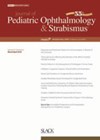
Journal Reviews
Combined versus traditional photocoagulation treatment for aggressive posterior retinopathy of prematurity (APROP)
The purpose was to report the outcomes of the combined treatment of sparing laser photocoagulation and intravitreal Bevacizumab (IVB) treatment versus conventional laser photocoagulation intervention in APROP. This was a study of 18 eyes of nine infants. One was excluded...
Treatment and outcomes for Peters anomaly (PA)
The purpose of this study was to evaluate the experience of patients with Peters anomaly (PA) and their treatment results. The study reviewed records of 27 patients (32 eyes); 74% male. Treatment included medical follow-up, optical iridectomy and penetrating keratoplasty...
Use of YouTube videos in providing amblyopia treatment information
This study aimed to evaluate the usefulness of YouTube videos on the treatment of amblyopia, where parent education is important for treatment compliance and success. A YouTube search was made in March 2020 for amblyopia treatment yielding 534 videos. They...
Optic canal measurements in children
The authors aimed to determine the normal range of optic canal diameters in a Turkish pediatric population. They evaluated 200 CT examinations: 102 females, 98 males with mean age of 86.42 ±65.39 months (range 1-211). There was no significant difference...
Presenting and diagnostic signs of retinoblastoma
This study revisits the presenting signs of retinoblastoma (RB) in the context of current best practice with respect to diagnosis and assessment of RB. This was a retrospective review of 131 consecutive cases, excluding those with positive family history over...
Exotropic angle by PACT vs under translucent cover
The authors aimed to validate the photographic analysis with a translucent cover by comparing the results obtained from this analysis with the angle obtained by prism cover test (PACT) in patients with intermittent exotropia. This was a retrospective review of...
Improving distance stereopsis in intermittent exotropia with training
This study compared the control ability of patients with stereopsis and analysed the influencing factors of the improvement of distance stereopsis in children with intermittent exotropia. Seventy-eight children were recruited: 33 male, 45 female with mean age of 8.4 ±2.72...
Germline mutation risk in solitary unilateral retinoblastoma
This study aimed to determine the true risk for germline mutation in a child presenting with solitary unilateral RB and whether this risk differs by age at presentation. This was a retrospective review of 482 cases from 1972-2020. Age groups...
Combination surgical management for congenital lacrimal duct obstruction
The authors aimed to report the clinical outcomes of antegrade balloon dacryocystoplasty (DCP) followed by pushed-type monocanalicular (MC), combined as a primary management for congenital nasolacrimal duct obstruction (CNLDO). This was a retrospective study of 62 eyes (48 patients) with...
Comparison of treatment regimes for APROP
The authors evaluated the risk factors and treatment outcomes of various treatment options for APROP including intra-vitreal anti-VEGF injections, laser treatment and a combination of both. This was an observational study of all consecutive cases of untreated APROP from 2018-19...
Presentation profile for sports-related ocular injuries
This study sought to examine the initial presentation of sports-related ocular injury in youths presenting to a US tertiary eye centre. This was a retrospective study of cases with a one-year follow-up period. Over a five-year period of 2010-15, 3965...
Screening outcomes for Syrian refugee children
This study compared two commonly used photoscreeners in a Syrian refugee camp in Jordan to better understand what types of technology would function best in a low-resource setting. The children in this study were assessed with the PEEK acuity application...





